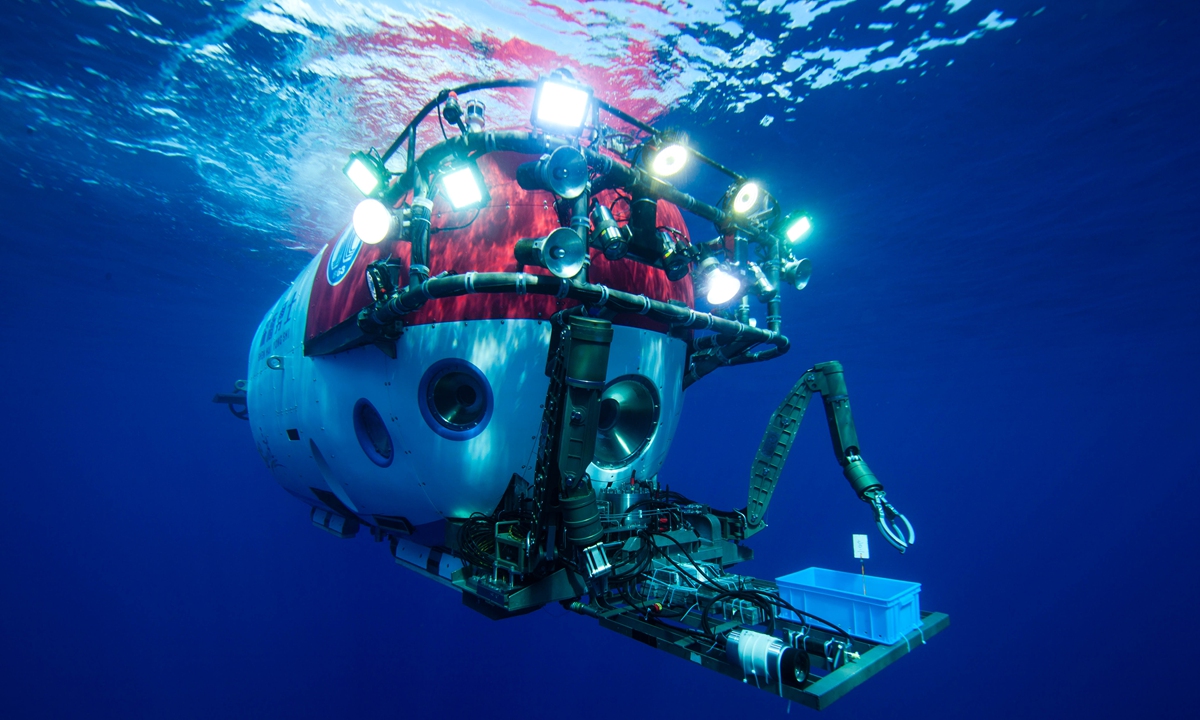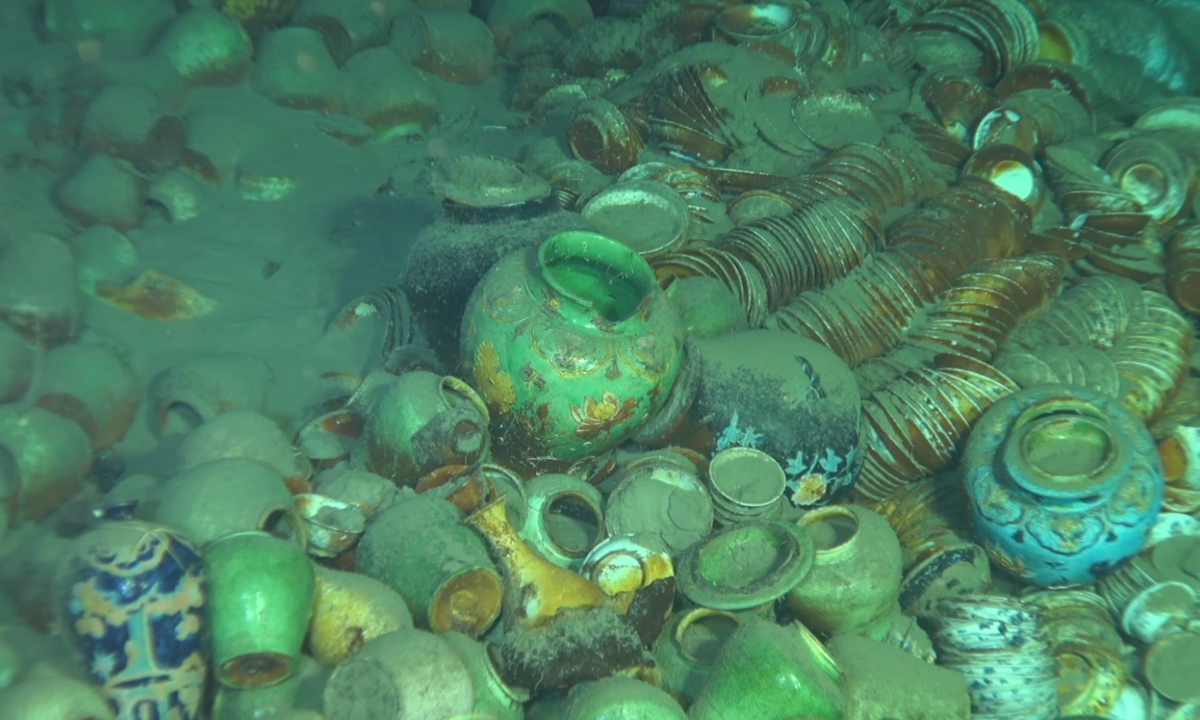
The deep-sea manned submersible Shenhai Yongshi, or Deep Sea Warrior Photo: VCG
Thousands of meters under the South China Sea, two
ancient shipwrecks carrying numerous cultural relics had "slept" for hundreds of years before they were discovered by Chinese archaeologists in 2022. The find stunned the whole world.
The two shipwrecks were discovered at a depth of about 1,500 meters using the submersible
Shenhai Yongshi, or
Deep Sea Warrior, in October 2022. The relics are in piles in various compartments; the highest pile is more than three meters high.
The No.1 wreck mainly contains porcelain wares, roughly more than 100,000 pieces dating back to the reign of the Zhengde Emperor (1506-1521) of the Ming Dynasty (1368-1644).
The No.2 shipwreck mainly contains a large number of wood logs, most of which have been processed. Through a preliminary study, it was determined that the ship was loaded with cargo and had sailed from overseas to China. It dates back to the reign of the Hongzhi Emperor (1488-1505) of the Ming Dynasty, according to China's National Cultural Heritage Administration (NCHA).
"The wrecks are both relatively well-preserved and a large number of relics have been uncovered," Yan Yalin, director of the archaeology department of NCHA, said at a press conference held Sunday in Sanya, South China's Hainan Province.
"The well-preserved relics are of high historical, scientific and artistic value. It may constitute a world-class deep-sea archaeological discovery," he added.
Song Jianzhong, head of the archaeological project and a researcher at the National Centre for Archaeology, told the Global Times on Monday that in the middle of the Ming Dynasty, China often imported timber from Southeast Asia. He explained that the timber was usually used to build buildings, like the palace of the emperor. However, further research is needed to uncover more details.
On Saturday, officials from NCHA embarked on a landmark deep-sea archaeological investigation of the No.1 shipwreck by establishing a permanent underwater mapping foundation in the southwest corner of the shipwreck site and conducting preliminary searches, according to NCHA.

Porcelain wares found at a shipwreck in the South China Sea Photo: Courtesy of the National Cultural Heritage Administration
'Milestone significance'
Experts noted that this "groundbreaking" discovery demonstrates the advanced technological capabilities China has developed in the field of marine archaeology, opening a new chapter in the country's exploration of deep-sea archaeology.
Tang Wei, director of the archaeological research center of the NCHA, said at the conference that the archaeological task of the two shipwrecks "is of milestone significance" for the development of China's deep-sea archaeology. He highlighted several key achievements in this groundbreaking discovery, including the first use of rigorous archaeological methods combined with high-tech underwater equipment and platforms to investigate ancient shipwreck sites at a depth of over 1 kilometer.
Moreover, the two ships are of similar age and lie just about 10 nautical miles (18.52 kilometers) apart.
This is the first time that China has discovered two ancient vessels, one leaving and the other returning, in the same sea area, which fully demonstrate the importance of the sea route and the booming trade at that time. Using these relics, archaeologists can conduct an in-depth study on the two-way exchanges along the Maritime Silk Road in ancient times, Tang added.
Ye Daoyang, deputy director of the Maritime Silk Road Museum of Guangdong's Underwater Archaeology and Technology Department, told the Global Times that the two shipwrecks and the
Nanhai No.1, a shipwreck dating back to the Song Dynasty (960-1279), date to different dynasties and so represent different stages of maritime trade, but they all show traces of Chinese activity in the South China Sea, and so they are significant in China's maritime history as well as the study of the Maritime Silk Road.
Leading the way Chinese experts from the Chinese Academy of Sciences (CAS) noted that over the past decade, CAS has established a new institute for deep-sea science and engineering while developing several cutting-edge deep-sea research platforms and cultivating a skilled team of underwater operators. With promising future developments on the horizon, China is poised to continue leading the way in deep-sea archaeological exploration and development in marine technology.
Ku Weiqun, an official from CAS, said at the conference that the academy established the Institute of Deep-sea Science and Engineering in Sanya in 2011, and has developed some advanced landers, making China the fourth country in the world with the ability to detect objects at a depth of over 10,000 meters.
This investigation utilized a range of advanced technologies and equipment, including permanent underwater mapping markers, long baseline positioning techniques, and various recording methods. New equipment such as flexible robotic arms and sandblasting devices also proved critical to accurately survey and extract cultural artifacts from these complex deep-sea environments.
According to Ku, China's progress in this field provides an exciting glimpse into the future of marine archaeology and technology worldwide, as they continue to invest in research and development to meet the growing demand for broader coverage, deeper dives and higher precision in deep-sea observation and excavation.
Chen Chuanxu, a scientist at the Institute of Deep-sea Science and Engineering, said the two shipwrecks were discovered during the 500th dive of the submersible
Deep Sea Warrior. In the following work, China's scientific research vessel
Tansuo 1 and
Tansuo 2, equipped with the submersible
Fendouzhe, or
Striver, will join the mission for further exploration.





